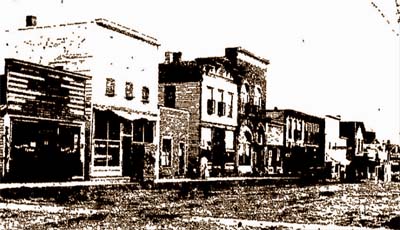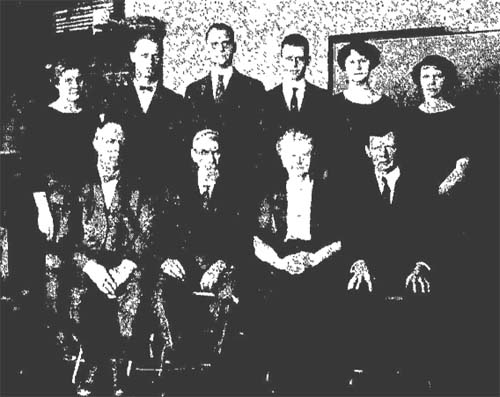Alexander Diamond Jubilee
1885-1960

Above: Main street, Alexander, in
1912. This photo did not reproduce clearly from
the microfilm. In front of the second building
from the left, The E.R. Green Furniture store, is
the first gas pump in Alexander. On the right,
the white building was the first bulding built on
the south side of the railroad tracks. It was
then the Tom Scott store, operated by C.C.
McGuire. At the time of the photo it was a
restaurant.

Family photo on the occasion of
the 50th Anniversary of Mr. & Mrs. A.B.
Arnends, who were among the first settlers in
Alexander.
Front, center: Mr. & Mrs. A.B. Arneds
Front, left: Ben Arends
Front, right: John Arends
Back, L-R: Mrs. Oscar (Marie) Hensel, of
Alexander; Grover C. Arends, of Williams; Rev.
Sherman Arends, of Los Angeles; Rev. Edwin
Arends, of Pecatonice, IL; Johanna Butler, of
Hampton; and Mrs. Harriet Bohlen, of Clear Lake.
Scott township was one of the last to
be organized in Franklin county. Prior to 1878 it was
a part of Morgan township. In 1878 an election was
held at the home of R.N. Meeker and township officers
were elected.
Up to the latter 1880's Scott was comparatively new
and little developed, because large tracts of land
were held by speculators. The first settler, a man by
the name of Mahn, came to Scott township in 1860 and
remained two years.
John Martin soon followed as manager of the Cobb
farm, a tract of land containing something over five
thousand acres. The land was improved and sold to
William Wright in 1860 who erected the first house in
the township. Later the land was sold to Henry
Corwith who in turn sold the land to T.B. Scott in
1872. Large herds of cattle and horses grazed on this
land and were prepared annually for market.
Others who came to Scott township in the 1860's were
Mr. Dallymple (sic), Mr. Pufier, Jacob Lewis and R.U.
Meeker. In the 1870's John D. Demaris, Peter Hanson,
A.C. Peterson, Henry Palmer and Jacob P. Johnson came
to the enlarging settlement.
E.B. Hill came to Alexander in 1882 after living at
Maysvile and Hampton. He opened a general store in
Alexander, attended the station and was named
postmaster.
Other early settlers were Christian Schonsburg, Onne
Suntken, John Stoff--s, Ben Arends, Paul Bobst,
Wilbur P. Ammerman, Philip Sce-er, Chet B. Johansen,
J.H. Bergheten, J.H. Tobias, C.H. and George
Muhlenbruch, Henry Plagge and Frank Ostendorf.
The first residents of the township to be married
were David Keves and Minnie Schteck, in 1878. The
ceremony took place in Hampton. The earliest birth
was William Wright in 1866. The first deaths were two
children killed by lightning at the home of J.D.
Demaris.
The first school house was erected in 1880 on the
northwest corner of section 28. The ground was
donated by Harry Yaw. the consolidation and erection
of the present building was done in 1914.
Many of the early residents had been members of the
Danish Lutheran Society in Marion township and they
held their first service in Scott township at the
J.P. Johnson home in 1881. Rev. J. Jensen, of Cedar
Falls, conducted the service.
In 1881 a branch of the Central Railroad of Iowa was
completed through the township aand its station was
Alexander. E.G. Hill was the first agent. In order to
build the railroad the slough southeast of Alexander
had to be filled. Jim Green was one of those who
helped cut and haul hay to fill in the slough. It is
recalled that they used everything they could find to
help fill the slough. The first station was replaced
a few years later, but was destroyed in 1925 by a
tornado.
F.E. Carter laid out and platted Alexander in 1885.
the town was incorporated in 1902 and in 1914 had a
population of about 300 persons.
Early progress was slow. In 1882, E.B. Hill opened
his general store in a building built by Bob Rickell,
and became postmaster. Reports say that the first
building north of the tracks was built by Abe Carter.
Then the depot was build and an elevator, all north
of the tracks. The store burned down in 1885 and the
first building south of the tracks, the Tom Scott
building, which was the C.C. McGuire store was built.
The Alexander Savings Bank was organized in 1899.
W.L. Robinson was president; G.A. Robinson, vice
president; and James Cook and George Dunn were
cashiers.
Another building which was constructed in 1885 was
the Undercoffer Blacksmith Shop which was located on
the corner where the present Aldinger store is
located.
In 1921 fire destroyed the Henry Undercoffer
blacksmith shop along with the Hougs general store,
pool hall and the tonsorial parlors which dispensed
cigars and pop.
Fire also destroyed the elevator which had been built
by the Moore Brothers. After changing hands several
times a Wisconsin firm owned it when it was burned to
the ground in 1916.
Benjamin G. Cunningham established the first harness
shop where the present D-X service station is
located. Emmett Crosby operated the drug store in
Alexander.
On June 7, 1894, the Alexander cemetery was
established east of town. The first burial was of
Mrs. Reynolds, mother of Mrs. John Demaris.
Mrs. J.F. Douglass operated the first eating house in
Alexander and it was located at the end of main
street. Alva Gillett opened the first hardware store
and Ben Hansen the first meat market in town.
The first creamery was located at the extreme
southeast edge of town and in 1911 a Farmers Co-op
was organized and a new creamery built in the north
end of town with Harry Gates hired as buttermaker.
Religion, as it should, played an important part in
the development of the Alexander community and there
has been a succession of churches through the years
that has resulted in the fine edifice now located in
Alexander in which the community as a whole has had a
part.
A Methodist church was organized in March, 1888, and
in September 1897, a Congregational church was
formed. On June 11, 1925, a devastating tornado
destroyed this church building and resulted in the
formation of the United church made up of the
Methodist and Congregational congregations, using the
Methodist church building which had been remodeled
after the tornado. This building burned in 1946 and
the Congregationalists withdrew in 1947 and the
Community Methodist church was organized and built
the present structure.
St. John's Evangelical congregation had its beginning
in September 1892, and functioned until 1951.
~*~*~
The newspaper article also had a
photo taken of local citizens between 1900 and 1910
in the Ole Houg Store. Pictured are Fred Rodemeyer,
George Latch, Jim Green, Adolph Shallar & Ole
Houg. The photo reproduced very poorly on the
microfilm so has not been used here.
~Source of newspaper article & the photos: The
Chronicle, Hampton, IA, June 23, 1960
Note: The type-set was difficult to read. The
transcriber has made every attempt to accurately
transcribe the words, but some letters were very hard
to distinguish from others. Readers should expect
errors.
|
![]() Franklin county & community Histories
Franklin county & community Histories